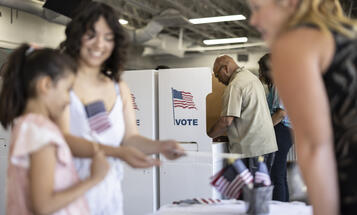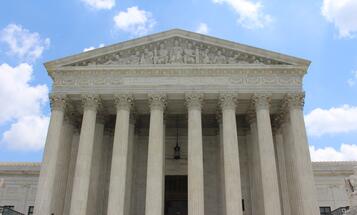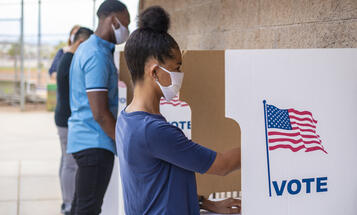
Disenfranchisement in US Prisons Thrives on Historically Racist Policies
Disenfranchisement laws have been deployed against people of color to imprison would-be-voters and keep political power concentrated in the hands of white men.
Last week on CNN’s “Town Hall,” the issue of restoring the right to vote to current and formerly incarcerated people was put to the 2020 candidates, eliciting a range of responses from Democratic hopefuls. The question to Senator Bernie Sanders was framed in particularly stark terms: “Do you support giving convicted terrorists and sex offenders the right to vote?”
The Senator’s answer was simple: yes. He argued that this issue is ultimately about the strength of our democracy, and that once you begin to pick and choose who loses the right to vote, you are headed down a slippery slope where an inviolable right can become an arbitrary one.
This was a powerful answer, but it doesn’t tell the whole story. The full truth, which has been well researched and documented, is that in the wake of Reconstruction states around the Union hurried to create laws to suppress newly emancipated black voters. One of the tools employed to achieve this goal was prosecution and incarceration, which would indirectly but permanently deprive individuals of the right to vote. Disenfranchisement laws were modified to ensure that they would most impact African Americans, who were regularly arrested for low-level crimes. The justice system would be deployed against people of color, would-be-voters would be imprisoned, and political power would remain concentrated in the hands of white men.
Disenfranchisement laws were modified to ensure that they would most impact African Americans, who were regularly arrested for low-level crimes.
In Mississippi, the state constitution was amended to disenfranchise those who commit burglary but not murder. In the words of the state’s high court, the purpose was to “obstruct the exercise of the franchise by the negro race.”
In 1876, Virginia enacted a constitutional amendment to disenfranchise voters for petit larceny. An opponent who spoke out against the bill stated that black people were more likely to steal out of hunger and more likely to be convicted because of biased police and judges. The amendment passed.
These laws were by no means limited to the South. In 1874, New York finally dropped a property ownership requirement that applied to black voters only, but at the same time amended its constitution to require disenfranchisement for any “infamous crime” in an effort to suppress the black vote. In the 2019 New York State legislative session, legislation has been introduced to restore the vote to individuals on parole. More and more states are acknowledging the problematic origins of these laws and the need to rectify racist policy. But in New York, even this first step has been met with opposition and claims that restoring the vote will harm public safety.
Overall, the marrying of criminal justice and voter suppression has had devastating consequences. Today, over 2 million people are incarcerated, the majority of whom are people of color. Research and data have shown that people of color are overpoliced and are more likely to face prosecution, conviction, and incarceration than whites for the same behavior. Black drivers are twice as likely as whites to be pulled over and four times as likely to be searched but are less likely to be found with contraband.
In addition, the increased use of plea bargaining, the process through which prosecutors offer reduced sentences to defendants in exchange for pleading guilty and forgoing the right to a trial, has created more opportunities for bias in our system. The rate of plea bargains began to climb after the Civil War and rose steadily until plea bargaining came to dominate our criminal justice system. The circumstances under which people accept pleas vary state by state, but prosecutors set the terms and often defendants are unable to see the evidence against them before making a decision that will change the course of their lives. Here too, evidence of racial bias is consistent. Black defendants are less likely to be offered reduced charges, and they get sentences that are almost 20 percent longer for the same crimes when controlling for age and criminal history.
The question posed to Sanders on Tuesday harkened back to the not-so-distant past where our overly punitive and discriminatory approach to criminal justice was supported by those on the right and left. The responses from the candidates also pointed to the uncertainty of our current moment. Candidates are being pushed to be explicit about their positions on issues like the restoration of the right to vote and reparations, both issues in which race plays a central role. Critics of giving people who are incarcerated the vote have tried to make the Boston Marathon bomber and Dylann Roof the poster children for the issue. This is a 1980s and 1990s style fear tactic. It demonizes everyone in prison rather than considering what it would take to reintegrate them into society. It paints with a broad and misleading brush a diverse population caught in a system that is itself deeply biased. This does little justice to either the debate or to the individuals impacted by the system.
Having the discussion on these terms also side-steps any acknowledgment of human rights abuses in prison, such as the horrific conditions documented in the Justice Department’s recent report about Alabama’s prison conditions, and practices such as solitary confinement, which many consider tantamount to torture.
Ultimately, instead of reducing the issue of voting in prison to frightening imagines and incendiary talking points, we should be asking the more fundamental question: What will it take to build a democracy in which all voices are heard?



